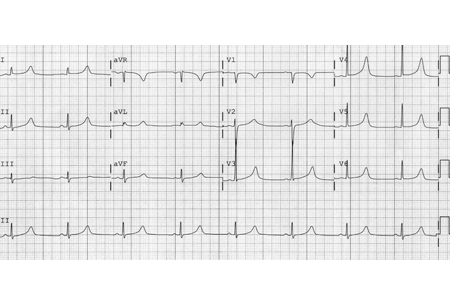Summary
Definition
History and exam
Key diagnostic factors
- history of known gene mutation
- use of drugs or circumstances known to increase the QT interval
- syncope during heightened adrenergic tones
- syncope during arousal or surprise
- arrhythmic symptoms postpartum
- syncope at rest and during bradycardia
- cardiac syncope
- palpitations
- periodic paralysis
- dysmorphic features
- sensorineural deafness
Other diagnostic factors
- dizziness
- angina
- fatigue
- oliguria
- muscle weakness
- tetany
- numbness
- Chvostek's sign
- Trousseau's sign
- cold and pale extremities
- hypotension
- confusion
Risk factors
- KCNQ1 gene mutations
- KCNH2 gene mutations
- SCN5A gene mutations
- QT interval-prolonging drugs
- hypokalemia
- hypomagnesemia
- hypocalcemia
- bradyarrhythmias
- central nervous system lesions
- female sex
- malnutrition
Diagnostic tests
1st tests to order
- ECG for LQT1
- ECG for LQT2
- ECG for LQT3
- ECG for hypokalemia and hypomagnesemia
- ECG for hypocalcemia
- ECG for complete atrioventricular (AV) block
- serum potassium
- serum magnesium
- serum calcium
Tests to consider
- Holter monitor
- exercise tolerance test
- echocardiography
- genetic testing
- epinephrine test
Treatment algorithm
Contributors
Authors
Mehmet K. Aktas, MD, MBA
Associate Professor of Medicine
University of Rochester Medical Center
Rochester
NY
Disclosures
MKA declares that he has received research grants from Astra Zeneca, Medtronic, and Boston Scientific. MKA has served as consultant for Abbott and Huxley Medical. MKA holds a patent for "ECG Clock Electrocardiogram Based Diagnostic Device and Method" (US patent #10,085,667). He is the author of a reference cited in this topic.
James P. Daubert, MD
Professor of Medicine
Duke University Medical Center
Duke Clinical Research Institute
Durham
NC
Disclosures
JPD declares that he has received honoraria for advisory boards, steering committees, data safety monitoring boards, events committees, and lecture fees from Abbott, Acutus Medical, Affera Inc., Biosense Webster, Biotronik, Boston Scientific, Farapulse, Gilead Sciences Inc., Medtronic, Microport, Phillips, and Vytronus; and research grants from Abbott, Biosense Webster, Boston Scientific, Farapulse, and Medtronic. He receives royalty payments from Wiley, Springboard and McGraw Hill for textbook authorship and educational materials. JPD declares that he has no stock, stock options, or other forms of ownership. He is the author of a reference cited in this topic.
Peer reviewers
Sami Viskin, MD
Director of Cardiac Hospitalization
Department of Cardiology
Tel Aviv Medical Center
Tel Aviv
Israel
Disclosures
SV declares that he has no competing interests.
Elizabeth S. Kaufman, MD
Associate Professor
Heart and Vascular Center
MetroHealth Campus
Case Western Reserve University
Cleveland
OH
Disclosures
ESK declares that she has no competing interests.

Guidelines
- European Heart Rhythm Association (EHRA)/Heart Rhythm Society (HRS)/Asia Pacific Heart Rhythm Society (APHRS)/Latin American Heart Rhythm Society (LAHRS) Expert Consensus Statement on the state of genetic testing for cardiac diseases
- 2022 ESC Guidelines for the management of patients with ventricular arrhythmias and the prevention of sudden cardiac death
Calculators
QT Interval Correction Opens in new window
More Calculators
Use of this content is subject to our disclaimer